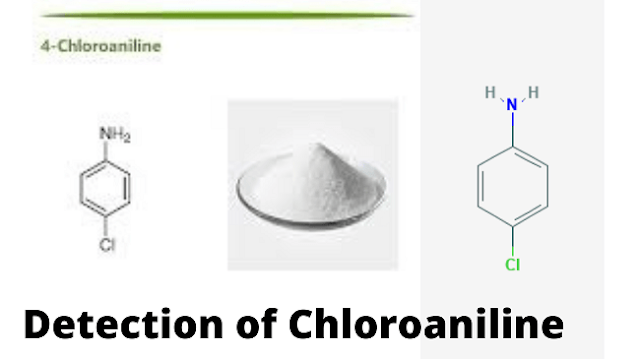Detection of Chloroaniline Resulting from the Interaction between Sodium Hypochlorite and Chlorhexidine Analyzed by Spectrophotometer.
Reagents
(a) Dimethyl sulphoxide, AR grade
(b) Hydrochloric Acid, AR grade
(c) Sodium nitrite solution 0.4% w/v,
freshly prepared
(d) Ammonium sulphamate solution 2%
w/v, freshly prepared
(e) N-(1-naphthyl)ethylene diamine
hydrochloride solution 0.1%, freshly prepared.
(f) n-Butanol , AR grade
(g) 4- chloroaniline and 3,4
dichloroaniline, AR grade
(h) Solvent mixture - DMSO 5 volumes
n-Butanol 2 volumes
distilled water 2 volumes
hydrochloric acid 1 volume
Mix n-butanol, water, and HCl. Cool the
mixture and add DMSO.
Procedure
Preparation of calibration curve:
1. Dissolve 0.3498g of 3, 4-dichloroaniline, and 0.2753g of 4-chloroaniline in a solvent mixture in 250 ml amber volumetric
flask.
2. Dilute up to mark with the solvent
mixture. 1 ml = 2.5 mg mixed chloroanilines(stock soln.) Dilute this stock
solution with a solvent mixture as given below :
a) Take 5 ml of stock solution and
dilute it to 250 ml with the solvent mixture. 1 ml = 50 μg mixed chloroanilines.
b) Take 5 ml of solution (a) and
further dilute to 250 ml with the solvent mixture. 1 ml = 1 μg mixed
chloroanilines. Use this solution for the preparation of the calibration curve.
Transfer using a burette 0, 1, 2, 5, 10, 20, 40 ml into 50 ml amber volumetric
flasks.
1. From a burette, add the sufficient
solvent mixture to make a total volume of 40 ml in each flask. The flasks are
incubated in a water bath at 25°C for 20 minutes.
2. After exactly 20 minutes, add 2 ml
of sodium nitrite solution into each flask and return them to the water bath
for exactly 10 minutes.
3. Then add 2 ml of ammonium
sulphamate solution into each flask and return them to the water bath for
exactly 10 minutes (swirl the flask occasionally).
4. Then add 2 ml of N-(1-naphthyl)
ethylene diamine hydrochloride solution into each flask and remove them from
the water bath.
5. Dilute to volume with distilled
water, mix, and allow to stand for 30 minutes. Measure the absorbance at 554 nm
against the blank solution.
Preparation of Blank Solution
1. Take 40 ml of the solvent mixture in a
50 ml amber volumetric flask. Incubate the flask in a water bath at 25°C for 20
minutes.
2. After exactly 20 minutes, add 2 ml
of sodium nitrite solution into the flask and return it to the water bath for
exactly 10 minutes.
3. Then add 2 ml of ammonium
sulphamate solution into the flask and return it to the water bath for exactly
10 minutes (swirl the flask occasionally).
4. Then add 2 ml of N-(1-naphthyl)
ethylene diamine hydrochloride solution into the flask and remove it from the
water bath.
5. Dilute to volume with distilled
water, mix, and allow to stand for 30 minutes. Use this blank solution for the preparation
of the calibration curve only.
Preparation of Graph
1. Prepare a graph by plotting the weight
(μg) of chloroanilines contained in each 50 ml flask against absorbance.
2. The linear calibration will pass
through the origin/or determine the average absorbance (AA) of 1 μg of mixed
chloroanilines by dividing the sum of absorbance of all different aliquots of the
standard by the sum of μg of chloroanilines in all different aliquots of standard.
Sample preparation for chloroaniline detection
1. Weigh 0.2 g of TCC into a 250 ml
amber volumetric flask and dissolve in a solvent mixture.
2. Dilute to volume with the solvent
mixture and mix well.
3. Filter through a Whatman no. 42
filter paper.
4. Transfer 20 ml of this solution
into a 50 ml amber volumetric flask.
5. Add 20 ml of solvent mixture. The
flask is incubated in a water bath at 25°C for 20 minutes.
6. After exactly 20 minutes, add 2 ml
of sodium nitrite solution into the flask and return it to the water bath for
exactly 10 minutes.
7. Then add 2 ml of ammonium
sulphamate solution into the flask and return it to the water bath for exactly
10 minutes (swirl the flask occasionally).
8. Then add 2 ml of N-1-(naphthyl)
ethylene diamine hydrochloride solution into the flask and remove it from the
water bath.
9. Dilute to volume with distilled
water, mix and allow to stand for 30 minutes.
10. Read the absorbance at 554 nm
against blank.
11. Deduce the number of
chloroanilines (μg) from the calibration graph curve.
Calculation of chloroaniline detection
Determine the number of mixed
chloroanilines in the aliquot of the test solution from the calibration curve.
250 M3
Chloroaniline content (in ppm) =
--------------
20 M2
Where,
M2 = Mass in g of TCC.
M3 = Mass (μg) of mixed chloroanilines found from the calibration graph or it can be calculated as given below :
Mass of the sample
M3 =
--------------------------------------------------
Average absorbance of 1 μg mixed
chloroanilines (AA)
Where,
Sum of the OD of the
standards
AA =
--------------------------------------------------
Sum of concentration of standard chloroaniline in μg

